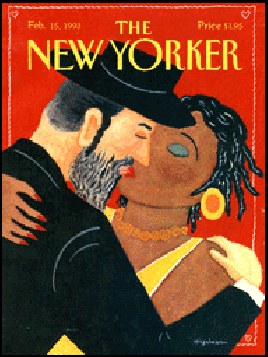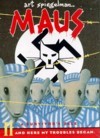| |
Links
(back to top) [links checked Jan. 23, 2012]
- Quotations and Resources
about Maus
- Comprehensive Study Guide (2016) at litcharts.com. It has detailed sections on:
- Context, Plot, Summary-Analysis, Themes, Quotes, Characters, Symbols
- All can be read online in expandable sections; downloadable as a single pdf with a $10 subscription
- This is really VERY comprehensive and high-quality
- Chapter
summaries, questions, cast of characters and other
resources (e.g. on graphic novels), by the Bucks County, Pennsylvania
Free Library project (2005; 2014 web archive version)
- Annotated Bibliography of nine articles and book chapters from 1991 to 2003 discussing Maus, by Prof. Marcuse's student Erin McGrath, Jan. 2008.
- Free Maus
"Cliff notes" at GradeSaver.com--character
sketches, chapter by chapter summaries, glossary, quizzes, etc.
- Maus
site with study questions, by Eveyln Burg at LaGuardia
Community College in 2005, developed to accompany a lecture by Spiegelman.
- How do you think Vladek and Anja survive Auschwitz?
- Why do you think Anja kills herself?
- Explain what you believe will happen to Vladek
and Mala’s marriage?
- What will happen with Vladek and Art’s
relationship? Why?
- Why did Spiegelman write this book? Why did
he call it Maus?
- Why did Spiegelman portray his father’s
story as a comic strip?
- Maus portrays the Holocaust or a genocide. A
genocide is a d eliberate and systematic destruction of a racial,
political, or cultural group . Do you know of any recent genocides?
How are these genocides similar to the Holocaust? How are they
different?
- What would you have done if you were a Jew living
in Poland during the Second World War? What would you have done
if you were a Pole? A German? Why?
- How did people survive in Poland during the
Second World War? How do you think these survivors felt after
the war? Why?
- In Maus, Art interviews Vladek about the Holocaust.
How reliable do you think Vladek’s memory is? Why?
- What happens to people who live under a terror
regime for a long period of time? Should people adapt to a terror
regime? Explain.
- Chapter
by chapter and general study questions, for
Cary Henson's Honors Composition Seminar at the University of Wisconsin,
Osh Kosh, Sept. 2007 (Jan. 2010: web archive version)
- Teacher's
Guide and Discussion Questions from Random House publisher
- 5
study questions by Eric Goldstein at Michigan State, for his
1999 "Focus on American Jewish Culture" course
- Geri Speace, "Maus,"
entry in St. James Encyclopedia of Pop Culture. Jan. 29,
2002, at FindArticles.com.
- 2
quotations about Maus, one from author Art Spiegelman,
published in Oral History Journal in 1987, the other from
scholar Stephan Feinstein in Witness and Legacy (1996)
(with references). [most links on the page don't work]
- Online Articles and Lectures
about Mause
- Joshua Brown, "Of Mice
and Memory," Oral History Review, Spring 1988.
(This seminal examination of vol. 1 is archived on this site [vol.
2 of Maus was published 5 years after this article was published].)
- Michael E. Staub, "The
Shoah goes on and on: Remembrance and representation in Art
Spiegelman's 'Maus'" Melus, Fall 1995. (14 page pdf).
- "Art
Spiegelman's MAUS: Working-Through The Trauma of the Holocaust,"
by Robert Leventhal (University of Virginia Dept. of German, 1995),
part of his hypermedia sourcebook [March 2006 version courtesy of
the web archive]
- "A
Generation Removed? A look at the relationship between Vladek
and Art Spiegelman," a somewhat chaotic & incomplete hypertext
essay by McGowen at Georgetown University
- Ian Johnston's 2001 lecture "On
Spiegelman's Maus I and II ," for his in Liberal Studies
112 at Malaspina University-College, Nanaimo, BC, Canada. (2012: courtesy of web archive)
- Oliver, Antonio S. "Art Spiegelman’s MAUS: A Different Type of Holocaust Literature," a 2002 Georgetown University essay.
- Hillary Chute, "Literal
Forms: Narrative Structures in Maus," Indy
Magazine, Winter 2005. Has detailed interpretations of 8 pages
from Maus. [1/10: web archive version]
- Martha Kuhlman, "Marianne
Hirsch on Maus," Indy Magazine, Winter 2005 [1/10:
web archive version]
- Print Articles and Book Chapters about Maus
- Bosmajian, Hamida. “The Orphaned Voice in Maus,” in: Considering Maus: Approaches to Art Spiegelman’s “Survival Tale” of the Holocaust, edited by Deborah R. Geis. Tuscaloosa: University of Alabama Press, 2003.
- Doherty, Thomas. “Art Spiegelman’s ‘Maus’: Graphic Art and the Holocaust,” American Literature 68, no. 1 (1996): 69-84. (16 page pdf)
- Gordon, Ian. "'But Seriously, Folks...': Comic Art and History," Review of History of the Comic Strip: Vol. 2, The Nineteenth Century by David Kunzle, and Comic Books as History: The Narrative Art of Jack Jackson, Art Spiegelman, and Harvey Pekar by Joseph Witek. American Quarterly 43:2(1991): 341-346. (6 page pdf)
- Levine, Michael G. “Necessary Stains: The Bleeding of History in Spiegelman’s Maus,” chapter X of Levine's The Belated Witness: Literature, Testimony, and the Question of Holocaust Survival. Stanford University Press, 2006.
- Mikics, David. “Underground Comics and Survival Tales,” in: Considering Maus: Approaches to Art Spiegelman’s “Survival Tale” of the Holocaust. Edited by Deborah R. Geis. Tuscaloosa: University of Alabama Press, 2003.
- Rothberg, Michael. “‘We Were Talking Jewish’: Art Spiegelman's ‘Maus’ as ‘Holocaust’ Production,” Contemporary Literature 35:4(1994): 661-687. (27 page pdf)
- Versaci, Rocco. "How Comic Books Can Change the Way Our Students See Literature: One Teacher's Perspective," The English Journal 91:2(2001): 61-67. (7 page pdf)
- Walser Smith, Helmut (ed.), The Holocaust and Other Genocides: History, Representations, Ethics (Nashville: Vanderbilt Univ. Press, 2002), 100-130. (12 page pdf)
- Young, James E. “The Holocaust as Vicarious Past: Art Spiegelman's "Maus" and the Afterimages of History,” Critical Inquiry 24:3(1998): 666-699. (34 page pdf)
- Interviews and Biographies
of Art Spiegelman
- Wikipedia
Art Spiegelman article; and Wikipedia
entry for Maus
- Comiclopedia
biography of Spiegelman (with pictures from his other comics)
- Don Swain, Interview
with Art Spiegelman, WiredForBooks.com, 1991 (47 mins.) [1/10:
web archive version--use the "listen" link, not the MP3
link]
- Chris Goffard, "The
Man Behind MAUS: Art Spiegelman in his own Words," The
Fish Rap Live! (1992 interview)

- Harvey Blume, "Art
Spiegelman: Lips," Boston Book Review, 1995 interview,
The title comes from Spiegelman's controversial 1993 Valentine's
Day New Yorker cover showing a Hasidic Jew and a Black
Woman.
- Art Spiegelman, "Those
Dirty Little Comics: The introduction to 'Tijuana Bibles: Art
and Wit in America's Forbidden Funnies, 1930s-1950s'," salon.com,
Aug. 19, 1997. (4 web pages). About the history of pornographic
comics. (2012: from web archive)
- Art Spiegelman, "Getting
in Touch with My Inner Racist,"Mother Jones, Sept.
1997. About his own racism.
- Susan Stamberg, Interview
with Art Spiegelman, NPR Morning Edition, January 26, 2004.
Click on "listen." Includes as "web extra" audio
of Vladek describing the death of Art's Aunt Tosha, his brother
Richieu, and his cousins.
- Comic Autobiography: Art Spiegelman, "Portrait
of the Artist as a Young %@?*!" Virginia Quarterly
Review, Fall 2005- (4 Installments; 2 not available; 3
shows origins of Maus in 1971; excerpt of 4 also available--link
at bottom of page)
- Art Director's Club, 2006
illustrated biography
- Pages with more resources
(most links
are included above already)
- 1996
bibliography of articles about Maus with ca. 110 items,
by Steven M. Bergson, librarian at the United Jewish Appeal Federation
of Greater Toronto [1/10: web archive version]
In June 2012 Mr. Bergson, now a UJA researcher, wrote to me to correct the spelling of his name and suggest several articles not yet listed here:
- "'When Time Stands Still': Narrative Organization and Traumatic Immediacy in Art Spiegelman's Maus and In the Shadow of No Towers," in Baskind & Omer-Sherman's The Jewish Graphic Novel: Critical Approaches.
- "The Raw Signing" by Scott Russo, Jizz #4 (3-page story) May 1991. Fantagraphics, in which Art is drawn as a Maus and he gives his reaction to Pekar's criticism of Maus.
- Simpsons episode "Husbands and Knives" Nov. 18, 2007 in which Art Spiegelman appears--with & without his Maus mask on.
- Fink #1 [Direct From Israel It's Fink! (Tales from the Ragin' Region, by Uri Fink)--Comic] amazon.com page; contains the story I reproduced. See page 10 here.
- Michael Abate's "The Night I Met Art Spiegelman He Just Won the Pulitzer Prize" is offline, but the first 3 pages are archived. In it, all the characters are drawn as mice. page 1, page 2, page 3. 7/16/13: The full comic series is again online at: http://babygorilla.com/warehouse/Stories/abate/abate1.html. In the last image, the author-artist removes his mask.
- 1999 bibliography
on Maus with 51 articles and 13 reviews, by UC
Berkeley librarian Gary Handman. Includes Library of Congress
catalog call numbers. (Good if you want to head for the library)
- Michigan
State's library bibliographies of Spiegelman's works, original
publications of Maus graphics, and some secondary works.
- 2002
linkography on Maus by Holly Schneider.
Unfortunately, many links are dead. Includes a brief bibliography.
[1/10: web archive version]
- Reviews
- Review
of the Maus CD-Rom by Roy Rosenzweig, included in his
1995 article "So, What's Next for Clio?: CD-ROM and Historians,"
originally published in The Journal of American History
81, 4 (March 1995): 1621-1640.
- Short
review of Maus by Jill Murphy, one of the founders
of the UK site TheBookBag, 2007 [1/10: web archive version]
- Books

- Art Spiegelman, MetaMaus: A Look Inside a Modern Classic, Maus (New York: Pantheon, [Oct.] 2011), 300 pages. ($22 at amazon; Random House page)
"In the pages of MetaMaus, Art Spiegelman re-enters the Pulitzer prize–winning Maus, the modern classic that has altered how we see literature, comics, and the Holocaust ever since it was first published twenty-five years ago. He probes the questions that Maus most often evokes—Why the Holocaust? Why mice? Why comics?—and gives us a new and essential work about the creative process. MetaMaus includes a bonus DVD-R that provides a digitized reference copy of The Complete Maus linked to a deep archive of audio interviews with his survivor father, historical documents, and a wealth of Spiegelman’s private notebooks and sketches."
|



